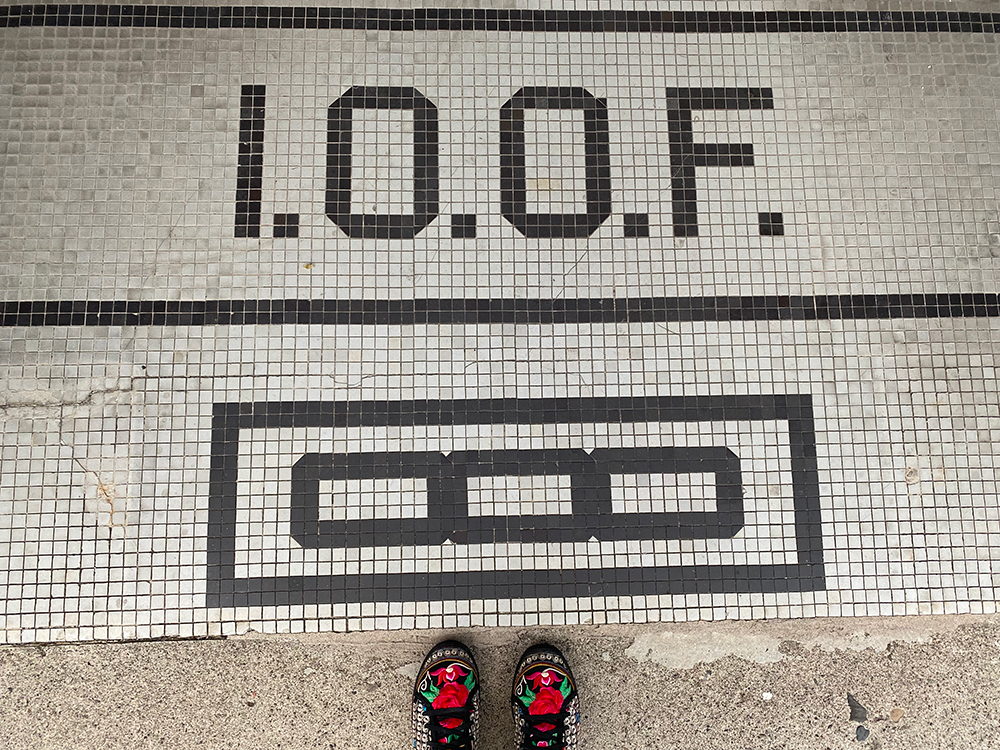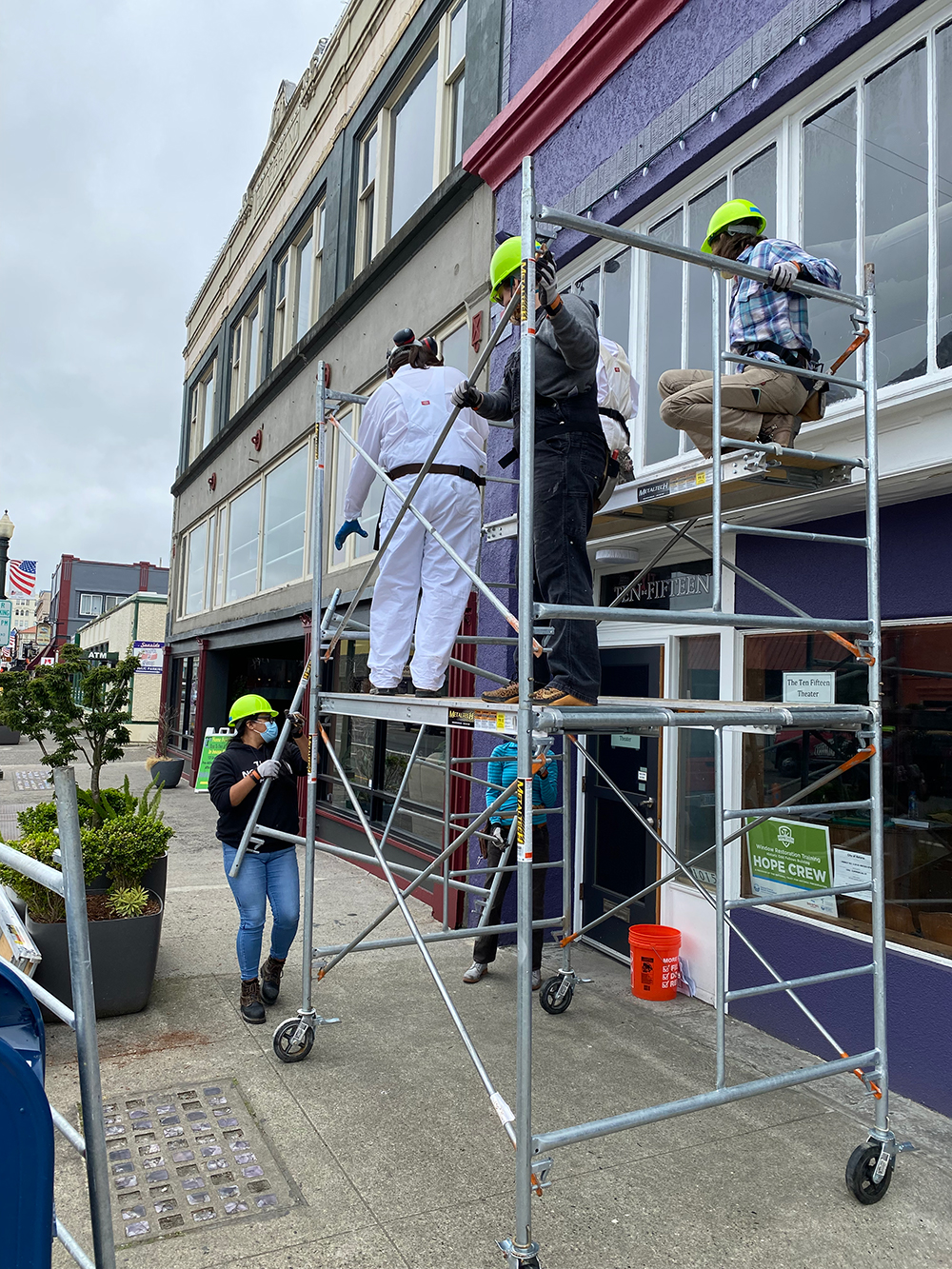There is something magical about Astoria. I’ve been trying to put my finger on it...is it the abundance of beautiful old houses? The hospitality of the locals? The charming downtown? One thing I have recently come to notice and admire is the quality of the light. Through the clouds or reflected off of the river, the light washes down onto the pavement and through wavy glass windows.
So when the opportunity arose to help restore the windows of the IOOF Building in Astoria, I jumped at the chance. The National Trust’s HOPE (Hands On Preservation Experience) Crew was hosting their first Where Women Made History project, with an all female leadership team and a majority female crew. The mission of the HOPE Crew is to spread knowledge of, and encourage participation in, the preservation trades. They host projects and trainings across the country, usually working with organizations and schools. This particular IOOF project was also their first in-person training since the pandemic, which presented its own array of challenges. One of these challenges was ever-shifting plans, which left the HOPE Crew leaders scrambling for individual participants at the last minute. The result was a small, rough-and-tumble crew, of which I was proudly a member.

The training began with a brief history of the IOOF Building. If you’ve taken a leisurely stroll through downtown Astoria, you would be unsurprised to learn that the IOOF Building on Commercial Avenue was constructed in 1923. It was rebuilt after the great fire of 1922, along with the rest of downtown. Its reconstruction was a community effort, and its restoration has been no different.
You see, in 2017 the IOOF building went up for sale. At the time, it housed four businesses that were owned and operated by female community members, including a dance studio - The Astoria Arts and Movement Center. All of this was suddenly in jeopardy when a potential buyer from Portland showed up on the scene, with a plan to “make Astoria cool.” The new plan included evicting the current business owners and remodeling the interior, turning the Arts and Movement Center into a bar and music venue. Desperate to rescue the IOOF building and its tenants from this unthinkable fate, three women from the community stepped forward to purchase the building together. With their combined efforts, and the support of their community, they were able to successfully obtain the building and retain the current tenants.
The three new owners were then able to secure a grant from The National Trust and Benjamin Moore, which allowed for repainting of the facade. Unfortunately, there wasn’t enough time to repair the windows before the scheduled painting (and subsequent Benjamin Moore photoshoot). This meant that the windows looked nice from far away, but closer inspection revealed their sad state. Luckily for the windows, the HOPE Crew leaders had enlisted the help of glass expert Ariana Makau, who took a break from her stained-glass restoration business, Nzilani, to lead the project.
The pandemic had prevented Ariana from performing the usual site-assessment visit, so most of the problem-solving and planning was happening in real-time. Immediately, Ariana suspected that the glass wasn’t original. It lacked the imperfections of older glass, and it was also ill-fitted - the height worked well, but the width was far too short, leaving gaps where wind and moisture could squeeze through.
Furthermore, the glass was held in place with silicone instead of traditional putty. Usually, historic windows begin with a wood frame that has a “rabbet,” or shelf, on the interior of the frame where the glass can sit. Before the glass is laid into the frame, putty is applied to the rabbet, making a “back-putty” bed for the glass to rest on, to seal and hold everything in. After the glass is laid on its bed, putty is applied to the front of the glass, sealing it in on the exterior as well. The previous window workers not only used silicone instead of putty - they didn’t back-putty (or back-silicone?), so the interior glass sat directly against the wood. This meant that the glass was unstable, and there was a high risk of it falling out. Then there was the additional hurdle of not being able to access the interior of the windows. All this meant that we would be carefully restoring the windows in situ.

After we built our scaffolding, with two necessary trips back to the scaffolding rental retailer, we were ready to get our hands on the windows. We raised our planks so that we could sit while we began the tedious task of gently cutting out the silicone - but not too much, lest the window panes fall out.
As we scraped, and chatted, we started to uncover more clues. The muntins (thin strips of wood dividing the window panes) had deteriorated in many places, leaving them weak and wobbly. The thin muntins, usually patched with wood putty, had instead been patched with...silicone. Scraping back the silicone revealed tiny circles in the wood: marks left by an orbital sander! Upon closer inspection, the tiny scribble of circles extended beyond the muntins, lightly carved into the surrounding glass. This meant that the operator of the sander slipped every now and again, and the sander scraped the glass. Ariana noted this was further evidence that this glass wasn’t original - glass from 1923 would likely shatter when hit with an orbital sander.
By the first week we had scraped out the silicone from only half of the windows. We admitted to ourselves that, with only one week left, we needed to reassess our project goals. There wouldn’t be time to finish all of the windows, and we didn’t want to leave any windows without protection - even if that protection was only poorly applied silicone. Instead, we refocused on the windows we had started, and agreed that we would make the most out of our time to make sure they were adequately weather-tight. We made a very thick application of putty to make up for the short glass, hopefully extending the life of those windows by a few more decades at least.
Before breaking down our scaffolding, we carefully cleaned off the glass. As I worked, I wondered, not for the first time, about the silicone-enthusiasts who had repaired the windows before me. Did they need to make haste? Did they have limited time and materials? Why such a low-grit sandpaper for the orbital? As I had cut out silicone and pressed in putty, I had pondered on who did the work and when. And I also wondered, how long before someone would work on these windows again? Perhaps they would be perplexed by the thick putty application on only half of the windows. Maybe, decades from now, someone will once again scrape these windows, under that magical Astoria light, and wonder to themselves about me.

